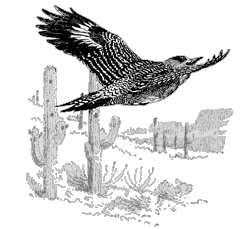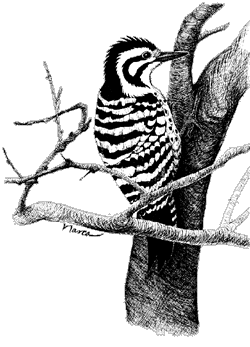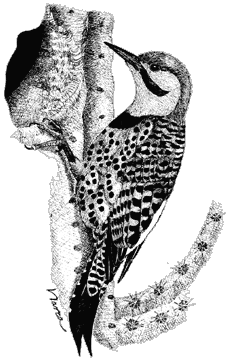Woodpeckers
We expect woodpeckers to be in the woods, so it may seem surprising that some are conspicuous in the desert. But for Gila Woodpeckers and Gilded Flickers, saguaros serve in place of trees: these woodpeckers go hitching their way up the sides of the giant cactus, and give voice to strident calls when they reach the top. The holes that they excavate for nesting sites—which may riddle the arms of some ancient saguaros—remain to serve as natural birdhouses for a variety of other birds.
 |
Most woodpecker species feed mainly on insects, seeking them out among the irregularities of tree bark. In the desert, these birds must be more resourceful. Gila Woodpeckers eat cactus fruits, mistletoe berries, and many other items in addition to insects. Highly adaptable, they make themselves at home in southwestern U.S. cities, where they will visit hummingbird feeders and steal dog food from back porches. (They also make themselves unpopular at dawn by hammering out brash wake-up calls on metal pipes and other echoing objects.) Gilded Flickers spend much time foraging on the ground; they are among the few birds that regularly eat ants. Ladder-backed Woodpeckers, among the smaller members of this family, make their living in a more traditional woodpecker style on the trunks of mesquites along desert washes.
—Kenn KaufmanSonoran Desert species:
Gila Woodpecker (Melanerpes uropygialis)
Ladder-backed Woodpecker (Picoides scalaris)
Gilded Flicker (Colaptes chrysoides)
Order: Piciformes
Family: Picidae
Spanish names: carpintero de Gila (Gila), párajo carpintero, picapalo
Distinguishing Features
 |
Gilded Flickers: Brown birds, with black barring on their backs and white rumps, visible as they fly; underside of wings and tail is golden. Gila Woodpecker: Brown face, black and white barred back, white wing patches that are visible when in flight. Ladder-backed Woodpecker: Black and white barred backs; face has black and white stripes.
Habitat
These woodpeckers are permanent residents that are found in all desert habitats.
Feeding
• Diet: As a group, woodpeckers are adapted to locating and capturing invertebrates living in the bark of trees. While these 3 species often look for insects on the side of a tree, they are also opportunistic. The flicker is often found on the ground eating ants, and all 3 eat cactus fruit.
 |
• Behavior: These woodpeckers have strong head and neck muscles, and the skull is adapted to absorb the shock as the birds drive their chisel-shaped bills into the tree. The tongue is long and can be extended; its tip is bristled and sticky. Short legs, strong toes, sharp claws and stiff tail feathers keep these birds secure on the vertical surface of trees.
Life History
Woodpeckers nest in cavities that they excavate. In the Sonoran Desert, Flickers and Gila Woodpeckers build nests in saguaros; the interior of the cactus provides a secure environment where the temperature is moderated year around. After the woodpeckers are finished with them, their nests are used by other birds—Elf Owls, Kestrels, Ash-throated Flycatchers, Purple Martins. According to some research, flickers and Gila Woodpeckers nest at different heights in the saguaro: flickers within 3 meters (10 feet) of the top, woodpeckers lower. The difference seems due to the fact that woodpecker nests are excavated in the outer cortex, whereas flickers need larger cavities, so their excavations go further toward the thicker center of the cactus—through the ribs and into the inner pith. Flicker bills are not adapted to heavy-duty boring: toward the top of the cactus the ribs are thinner and more easily severed. Flicker cavities may harm the saguaro, even kill it, because water is no longer transported through the vascular tissue of the severed ribs and because the excavation increases surface area/volume ratio leading to greater water and heat loss.










